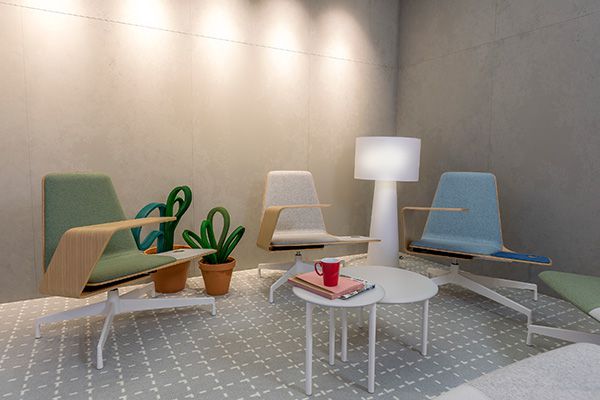Nicolai Czumaj-Bront has worked with Haworth as an industrial designer since 2005, and is now currently Haworth’s Design Lead for Europe. Having grown up in a creative household, he strives to design product solutions with an emphasis on translating the abstract into something tangible.

June 14th, 2016
The Harbor Work Lounge is one of Czumaj-Bront’s most distinctive contributions to Haworth, with its remarkable silhouette inspired by the shape of a relaxed, slightly curled hand. With a sleek suede wing extended out from the principal base of the lounge to mimic the last two fingers of the hand, and a sliding tablet arm that echoes the bends of the thumb, the overall look of the Harbor Work Lounge is one filled with elegant personality.
In the design process, Czumaj-Bront considered three principle questions at the heart of the design: “Where do you like to work, how do you like to work, and what do you need to work?”
With the rapid evolution of workspaces and a necessity for versatile furnishings to facilitate a myriad of alternative workstyles, the Harbor Work Lounge is lightweight and flexible, acting as both a cosy individual workstation, or as a more sociable and collaborative hub.
The paired ottoman functions both as a pullup stool for a guest and a spare surface for placing notebooks, while the sliding tablet arm is an easily maneuverable and practical surface for laptops. Its extended suede wing also possesses an in-built cup holder – perfect for individual focused work, with all resources easily on hand.
Haworth offers the capability to truly customise the Harbor Work Lounge with a plethora of different fabric and leather colour options for the body of the Work Lounge, to the extended wing segment. For the base, colour options include a vivid red, to the more traditional black, cream, and steel, whilst the tablet arm is available in either a rich walnut or oak timber.
For Czumaj-Bront: “Design shouldn’t be dictated by trends, nor should it remain in a particular style of field. Design is everything.”
In the Harbor Work Lounge, Czumaj-Bront has devised the perfect workstation for the ever changing modern workspace.
Haworth
ap.haworth.com
Haworth Collection
haworthcollection.com
INDESIGN is on instagram
Follow @indesignlive
A searchable and comprehensive guide for specifying leading products and their suppliers
Keep up to date with the latest and greatest from our industry BFF's!

A longstanding partnership turns a historic city into a hub for emerging talent

Gaggenau’s understated appliance fuses a carefully calibrated aesthetic of deliberate subtraction with an intuitive dynamism of culinary fluidity, unveiling a delightfully unrestricted spectrum of high-performing creativity.

BLANCOCULINA-S II Sensor promotes water efficiency and reduces waste, representing a leap forward in faucet technology.

In this candid interview, the culinary mastermind behind Singapore’s Nouri and Appetite talks about food as an act of human connection that transcends borders and accolades, the crucial role of technology in preserving its unifying power, and finding a kindred spirit in Gaggenau’s reverence for tradition and relentless pursuit of innovation.

The workplace strategist and environmental psychologist was in Sydney earlier this year to give a talk at Haworth on the fallacies of the ‘average’ in workplace design.

Andrea Mulloni is the head of sustainability at furniture manufacturer, Arper. With a particular emphasis on the evolving Catifa Carta chair, we chatted to him at Arper’s stand during Milan Design Week.
The internet never sleeps! Here's the stuff you might have missed

‘Second Century Modernism’ is a new book by American architect, John Jennifer Marx, and calls for a newly rebalanced modern movement with more paradox and community.

In Newcastle’s CBD, Coverite Projects transformed a blank floorplate into a workplace with soul, using Milliken flooring to balance industrial grit with residential warmth and intuitive wayfinding.

While the alluring myth of a lone genius can be particularly appealing, Knoll’s enduring legacy was built on a more profound reality: that a singular vision is only augmented through dialogue, proving that collaboration is one of the most transformative tools in design.